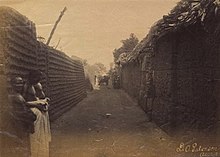Benin Moat
Today, remnants of the moats can still be found in Benin City, although urbanisation and land disputes pose challenges to their preservation.
They exposed invaders attempting to breach the city, resulting in their capture or meeting fierce resistance by Benin soldiers.
The towering walls discouraged climbing, making invaders targets for Benin soldiers armed with spears and poisoned arrows.
[13] The inner wall, approximately 10 kilometres (6.2 mi) long, encircled vital areas, including the Royal Palace and chiefs' residences.
[14] Access through this fortified earthwork required payment of a toll, contributing to the city's reputation for safety by subjecting visitors, including traders, to thorough scrutiny.
[18] The Benin Moat, possibly originally over thirty-five feet in width, surrounded the city and acted as a protective barrier.
[19] The moat maintained a consistent depth, an average width exceeding thirty-five to fifty feet, and a length over 13,000 miles (21,000 km).
In many cases, these moats now encompass multiple villages, leading to complexity in areas like Benin City due to urban expansion and ongoing development for housing and industrial purposes.
[8] As a result, some villages assert ownership claims over parts or the entirety of the moat enclosures, citing their longstanding presence in the area, even if it means displacing the original inhabitants.
[2] Land disputes in the courts often involve clashes between the original owners of Iya or moats enclosures and newer settlers claiming ancestral rights.
[7] Portions of the moats have yielded to residential and commercial development, experienced degradation from drainage projects, and been transformed into refuse disposal sites.
[27] One of the earliest accounts of the Walls of Benin was given by Olfert Dapper, a Dutch physician and writer who published a book titled Description of Africa in 1668.
[28] Dapper never visited Africa himself, but he compiled his book from the reports of Dutch travellers and missionaries who had explored various regions of the continent.
[9] In 1995, the Benin Moat, alongside Sungbo's Eredo, was added as an extension to the existing World Heritage Site of the Royal Palaces of Abomey, but it is still awaiting official recognition by UNESCO.

